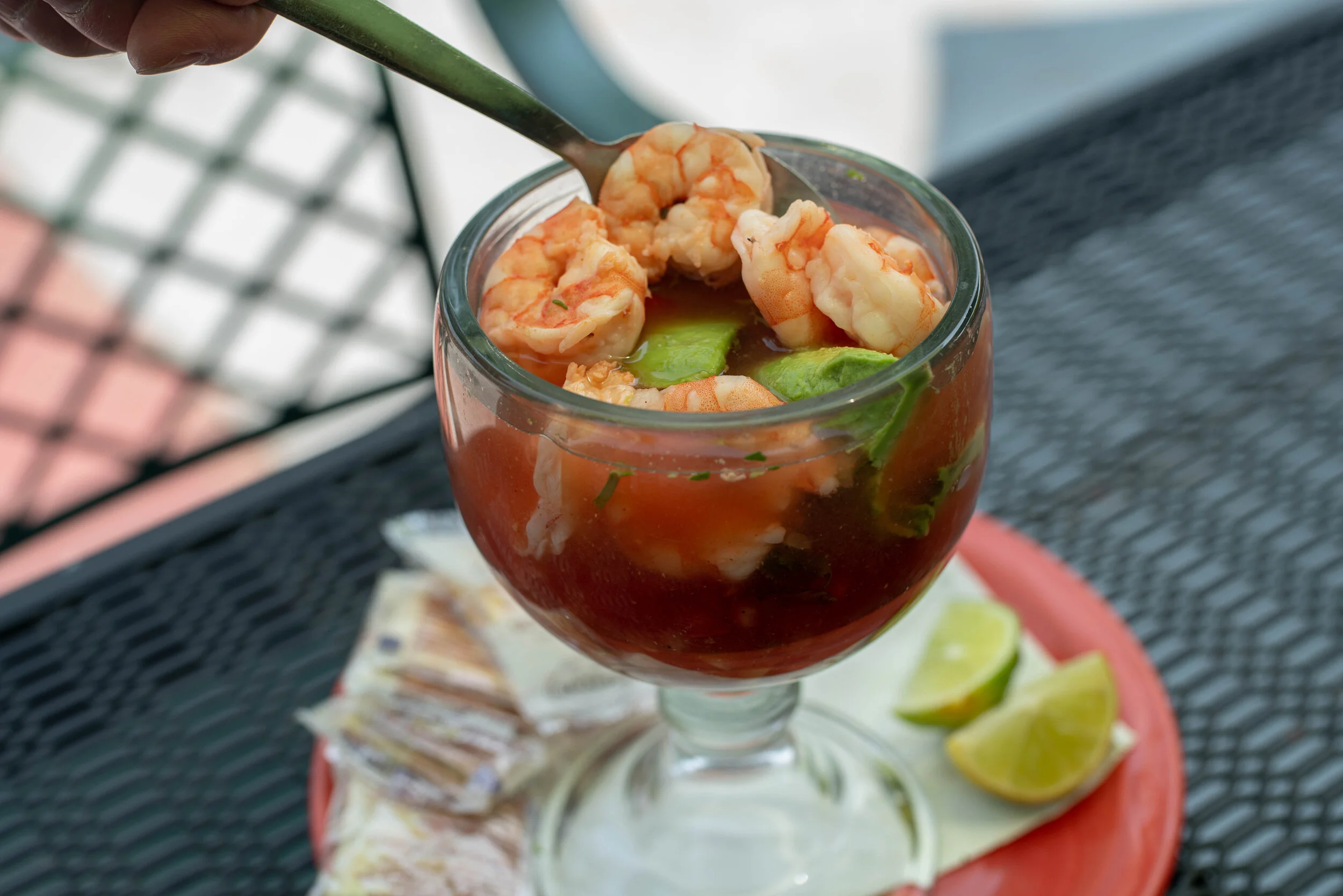Mexican seafood cocktails take time to “cook,” but are worth the wait in Greeley
The Mexican version of shrimp cocktail is called “Coctel de Camarón” and is traditionally served in a large goblet full of a tomato juice-Clamato mixture with diced onions, cilantro, avocado and lime juice. Featured is a Coctel de Camarón from Cazadores Mexican Grill and Cantina in Greeley. Photo by Emily Kemme.
By Emily Kemme
If you’ve ever been in a Mexican restaurant and observed someone spooning up shrimp from an oversized goblet of red liquid — a goblet that typically holds a greenish-tinged margarita — you’ve seen the delectable appetizer named Coctel de Camarón.
The Mexican version of shrimp cocktail has shrimp, of course, but it is submerged in a soupy mixture of tomato juice, Clamato, diced cucumbers, onions, tomatoes, avocado and cilantro. Some restaurants switch out tomato juice with ketchup, giving it a sweeter profile. But whatever makeup of the ingredients, ordering one takes time, so be patient, advises Hugo Topete, the manager at Cancun Mexican Grill & Cantina.
That’s because many of the classic seafood appetizer plates offered at his, and other Mexican restaurants offering them, take between 15 to 20 minutes to “cook.” In this case, cooking means immersing shrimp, raw fish or octopus into a mixture of lime juice and onions to let the fish cure. The Coctel de Camarón starts with pre-cooked shrimp, but still needs that time to produce sweet mouthfuls of shrimp partnered with refreshing, boldly flavored tomato juice. The briny immersion time acts to plump the already cooked shrimp.
Served with hot sauce so you can personalize the taste experience, and a plateful of saltine crackers, it’s the perfect chilled dish to eat right now. Often enjoyed as an appetizer, Mexican seafood can also make a great light meal.
To understand the idea of curing seafood, which is cooking without heat, it’s useful to understand the science behind the process. Acid is involved — in this case fresh juices squeezed from citrus fruits — in which the raw fish is immersed and marinated. According to Serious Eats, “As the pieces of fish sit in the marinade, the citric acid from the juice slowly causes the flesh’s proteins to denature, in very much the same way that heating will. The result is raw fish with the opaque appearance and firmed texture of cooked fish.”
The Torre Altata at El Coco Pirata in Evans is a mountain of seafood, including cooked shrimp, and cured octopus, shrimp aguachile, sliced cucumber, scallops and sashimi style tuna, topped with a fan of avocado slices. It’s surrounded by a spicy Sinaloa-style seafood sauce. Photo by Emily Kemme.
It’s not sushi, which is raw fish that’s not been denatured. But as with sushi, fresh fish is critical for preparing coctel de camarón, as well as other Mexican seafood delicacies. The fish isn’t raw, but the denaturing process doesn’t eliminate bacteria like cooking with heat does. That’s why eating these dishes from reliable sources is essential.
At Cancun Mexican Grill, the menu features an astonishing number of cured seafood options. Given that much of the restaurant’s focus is on seaside recipes typically enjoyed in Mexican resort towns like its namesake, Cancun, its menu provides a useful guideline. But there are many Mexican restaurants in the northern Colorado region with equal expertise creating this tasty cuisine.
Here are a few dishes to try:
Ceviche
Made from shrimp, oysters, scallops and pico de gallo with chopped onions, slices of avocado and cilantro, the Campechana Seca is a dry version of the coctel and hails from Campeche, a shoreline region in southeast Mexico on the Gulf of Mexico. You can also order this dish as a cocktail, served with tomato juices in a goblet.
Aguachile
Similar to ceviche, aguachile is a portmanteau of agua (water) and chiles. The signature dish of Sinaloa, a state in western Mexico, preparations sometimes include tomato or clam juices, onions, lime juice and always have plenty of hot chile peppers in the marinade. The dish will be spicier than ceviche because fresh peppers are added during marinating.
Cancun offers three versions: aguachiles verdes with precooked rock shrimp tossed with lime juice, salt and serrano pepper sauce; aguachiles Sinaloa style with a red Sinaloa styled sauce; and aguachiles Rojos, shrimp with red pepper sauce. All of the aguachiles dishes at Cancun are served alongside avocado and cucumber slices. Traditionally, aguachile is served immediately after immersing the shrimp in lime juice, but Cancun allows it the same marinating time as their other seafood dishes.
Torres de Mariscos
Arguably the star of the cured seafood lineup, the torres (tower) is a showstopper which Topete said is growing in popularity because it’s such a beautiful presentation.
The dish is built on a base inside a container and includes a ceviche made with tilapia, avocados, shrimp and cucumbers. Because of the combined time involved for curing the raw tilapia and building the tower, expect the torres to arrive on your table in about 20 to 30 minutes. A marvel of both culinary engineering and science, Topete said the ingredients are squished down tightly during the build and then the mold is removed. Miraculously, all the ingredients stay together.
Paired with a Michelada (beer mixed with spiced tomato juice, lime juice and salt) a standalone Mexican beer or a margarita, any of these fresh seafood dishes will have you appreciating the culinary arts of Mexico with each bite.
Where to find Mexican seafood in Greeley
Cancun Mexican Grill & Cantina | 5415 West 11th St. in Greeley | (970) 352-5417
El Coco Pirata | 2812 11th Ave. in Evans | (970) 702-2239
Cazadores Mexican Grill and Cantina | 2140 35th Ave. in Greeley | (970) 330-7711
El Cielo Mexican Restaurant | 3645 W 10th St. in Greeley | (970) 352-1800
3 Margaritas | 2297 Greeley Mall, in Greeley | (970) 378-6662
El Pueblito Mexican Restaurant | 2435 W 10th St. in Greeley| (970) 346-1143


